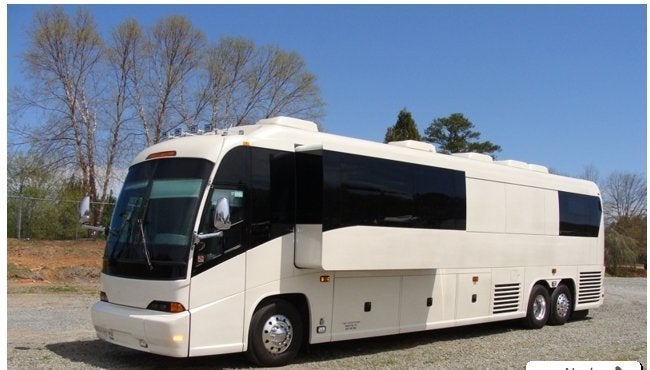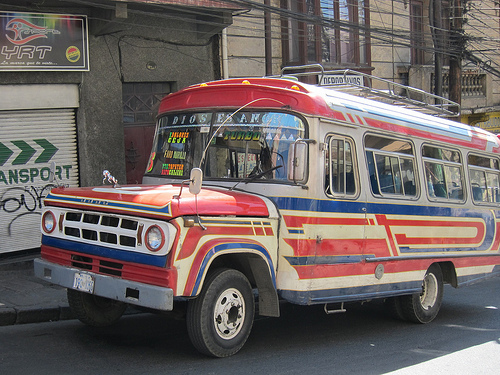
Sorry, frequent flyers. In South America, overland travel is king. Whether you're visiting for a short vacation or a multi-month backpacking adventure, you're likely to encounter some bus time down here. But if the thought of spending anywhere from five to 24 hours on a coach makes you cringe -- or worse -- consider this: The buses are cheap, comfortable, and hey, it's how the locals travel.
After logging more than 200 bus hours across eight countries, I've learned a few valuable lessons. Here's what you need to know before bus-ting your ass in South America:
1. Overnight buses are safe and awesome
Solo female travelers needn't shy away from night buses: Quite simply, they are safe. Obviously, take normal precautions -- like sleeping with your carry-on bag wrapped around your ankle -- but that's no different from a daytime bus. And the benefits of the night coach are many. For one, you save money on accommodation; and secondly, you don't waste precious vacation days in transit.
There's something wonderfully stressful about waking up and suddenly you're in Cuzco, or Cuenca, or Cartagena. You're being jostled, and numbers for baggage are being shouted, and you are surrounded by men yelling "TAXI?!?" in your face. You can groggily find a hostel, and you have that entire day ahead of you because its 6 a.m. If you leave town on another night bus the next day, you've spent two full days there, and in some towns, that's enough. In others, it's enough to know you'll someday return. If you're traveling with limited time and want to see several cities, this is the way to do it.
2. The buses are freeeezing
Let me say it again: freezing. They keep these things cranked to bone-chilling, hypothermic, Alaskan winter levels of cold. It doesn't matter if you're departing from 100 degree summer in Rio or a high altitude chill in La Paz, the buses could make a polar bear shiver.
Each time I board a bus, I think, "This time, you won't freeze." Fast forward two hours and, without fail, I'm cursing under my breath, squirming to regain circulation, and attempting ridiculous improvised warming techniques. I've worn a sweater as pants to cover my sunburnt legs. I've stuffed my numb, flip-flopped feet into my purse. I've shoved a still-warm laptop into my shirt. I've ripped the smelly headrest from my seat and wrapped it around my face. I've even cuddled closer to the stranger next to me.
That said, consider wearing nearly every article of clothing in your pack, which also serves to lighten one's load. The best way, however, to avoid freezing off a pinky toe is with a fleece blanket and multiple pairs of socks. The blanket may seem like a waste of space in an already-crammed pack, but if you don't have your own, you'll only end up buying one from the overpriced rest stop vendors along the way.
3. Class matters
Many of the buses in South America are nicer than your standard regional airplane. The seats are spacious and comfy, often with leg rests, and they recline quite far. But not all buses are created equal. Companies like the popular Cruz del Sur in Peru offer upgrades to VIP seating. Choose Full Cama if you want a giant, leather, fully reclining seat and perks like warm towel service and snacks.
Not everyone needs pampering, but when money allows, a little upgrade goes a long way toward one's sanity. And you can bargain on price. It's not always successful, but it never, ever hurts. I usually ask for a price that's 10% to 15% lower, and if that fails, try for old faithful -- the student discount.
Don't buy your ticket from anyone but the bus company itself, usually at the station. Even seemingly legit tour companies are all too happy to rip you off. I once purchased a slightly more costly "VIP" ticket only to learn I paid almost double the actual cost for the most horrendous of local buses. The overnight ride started with what I observed to be a drug deal, then stopped every hour, sometimes circling blocks several times, adding around three hours to the journey. The interior lights remained on all night, and the woman behind me used her legs to stop me from reclining my seat even an inch. Oh, and then there were the chickens. Live ones. On the bus. Pooping, clucking, wandering around, doing the things live chickens like to do.
4. It never hurts to check on prices of flights
Sometimes, if you're lucky, you can find a quick in-country flight for less than the cost of the bus. For example, tickets from Medellin, Colombia, to Cartagena, cost me an expensive $60. Meanwhile, my friend found a two-hour flight for $50. Not bad. But remember to consider time spent waiting at the airport, the cost of getting to and from the airport, and whether there is an airport tax (anywhere from $10 to $40). Lastly, remember that Americans must pay a high reciprocal entry fee in Argentinean and Chilean airports, but you can enter the country by bus for free.
A few extra words of advice:
Bonus tip #1: Learn this word: subtitulos. Pronounce it: soob-TEET-tu-loze. Every bus will play at least one movie; they're typically poorly dubbed American films. Even if the movie looks truly horrible and you have no desire to watch, ask for subtitulos en ingles. Guaranteed, the sound will be so loud you can't ignore it, and it's too dark to try reading a book. Twenty minutes in, you'll be happy to at least follow the plot.
Bonus tip #2: Ask if the bus is express when buying your ticket. That distinction is not often made up front, and it can mean a difference of several hours.
This post first appeared at LostGirlsWorld.com. Photo credit: Travis Harwood